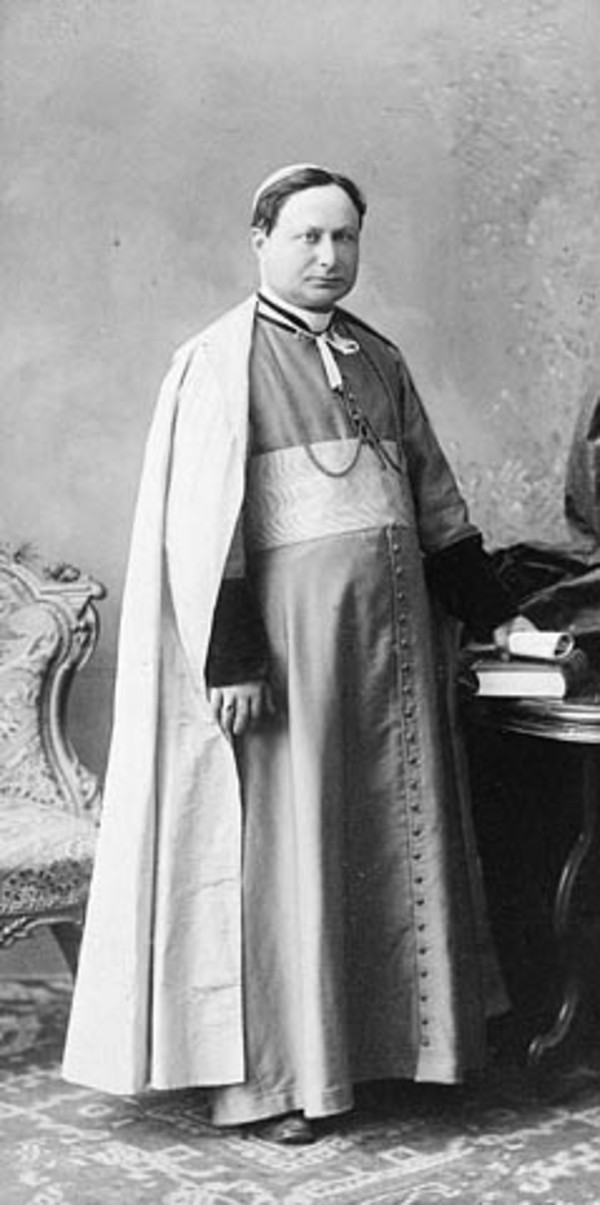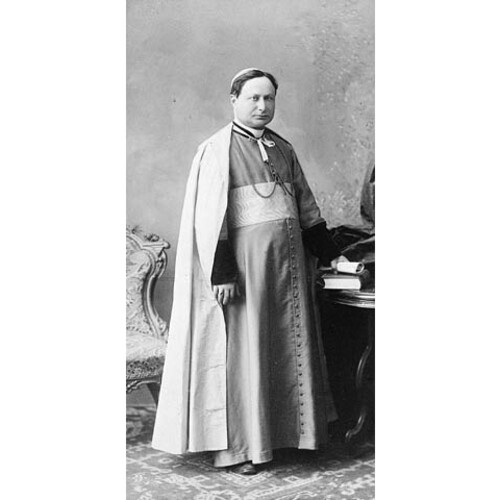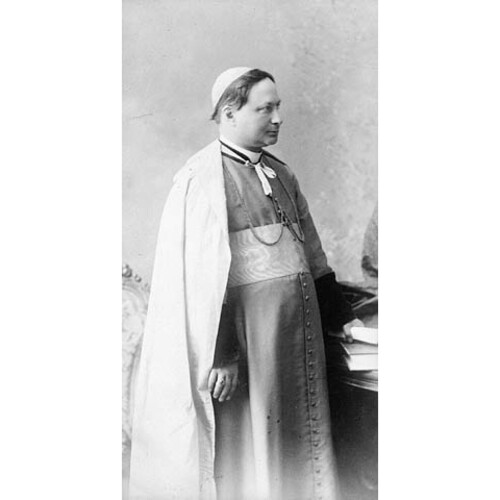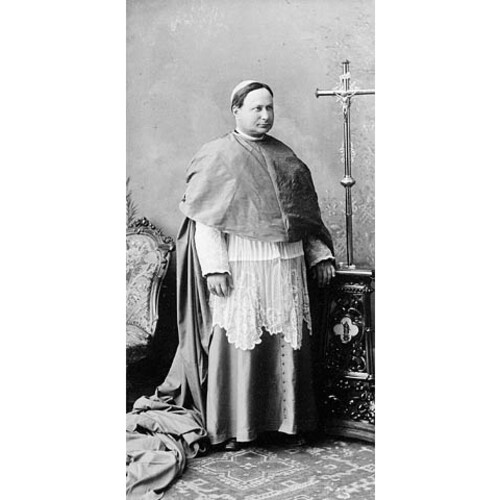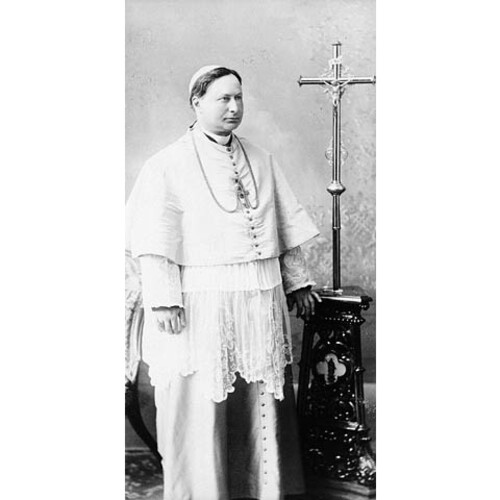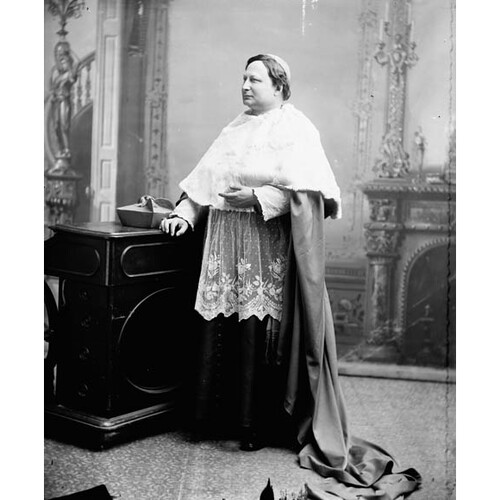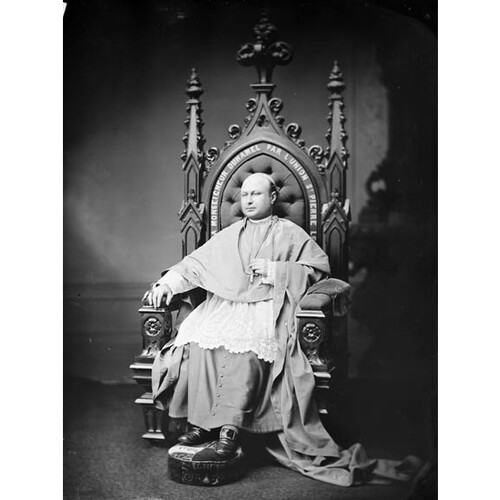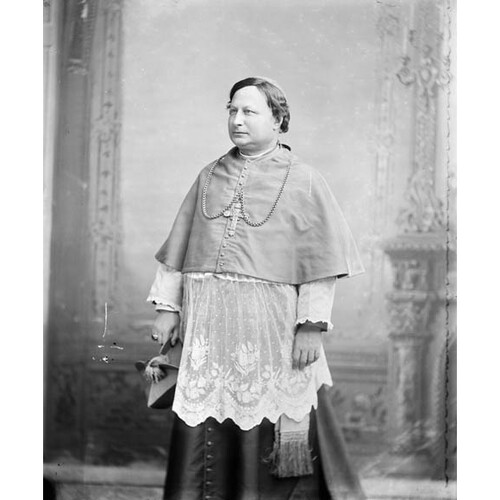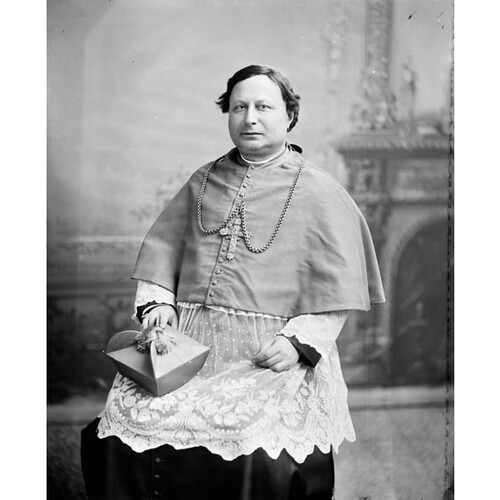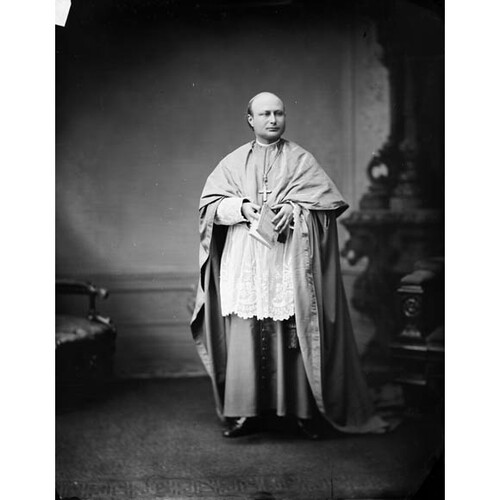DUHAMEL, JOSEPH-THOMAS, Roman Catholic priest and archbishop; b. 6 Nov. 1841 in Contrecœur, Lower Canada, youngest of the 12 children of François Duhamel, a blacksmith, and Marie-Josephte Audet, dit Lapointe; d. 5 June 1909 in Casselman, Ont., and was buried in Ottawa.
Joseph-Thomas Duhamel was two years old when his family moved to Bytown (Ottawa) in Upper Canada. His schooling, which he received entirely under the auspices of the Oblates of Mary Immaculate, began in 1848 at the newly established Collège Saint-Joseph (incorporated the next year as the College of Bytown and known as the College of Ottawa after 1861). He later studied under its principal, Joseph-Henri Tabaret*. In 1857 he entered the diocesan seminary and, while pursuing his theological studies, also taught at the college, a practice widespread among seminarians in Lower Canada in that period. Ordained priest on 19 Dec. 1863 by Bishop Joseph-Bruno Guigues* of Ottawa, Duhamel was briefly assistant priest in Buckingham, Lower Canada, before being named parish priest at St-Eugène, Upper Canada, in August 1864. His sermons and his fluency in English attracted the attention of his superiors, especially Bishop Ignace Bourget* of Montreal and Guigues; the latter asked Duhamel to accompany him to Rome in 1869 for the first Vatican Council.
The death of Guigues on 8 Feb. 1874 brought with it the difficult question of succession. The diocese of Ottawa, bounded to the east by the diocese of Montreal, to the south by that of Kingston, and to the west by the archdiocese of Toronto, straddled the Ottawa River. In the discussions leading up to the division of the archdiocese of Quebec and the creation of the ecclesiastical province of Toronto in 1870, Bishop John Joseph Lynch* of Toronto, with the support of bishops John Farrell* of Hamilton and John Walsh* of London, had sought to include the diocese of Ottawa under the jurisdiction of Toronto. Lynch was of the opinion that the location of the city of Ottawa in Ontario was reason enough to justify the transfer of the diocese, but he also felt that the national capital should have an incumbent whose first language was English. When the Quebec bishops disagreed because fully half of the diocese was in their province, the Ontario hierarchy sought to have the diocese divided in accordance with the civil boundaries. But the Quebec episcopate continued to resist, noting that half of the Catholic inhabitants in the Ontario portion were French Canadians. After 1870 Lynch, now archbishop, persisted in his arguments against the status quo in Ottawa. As a result, Guigues was so concerned about the future of his diocese that he implored his Quebec colleagues in 1873 to make sure that a French Canadian be appointed as his successor. He maintained that French Canadians could never expect to receive from an Irish prelate the fair treatment that a French Canadian would give to his Irish diocesans.
The Holy See rejected the call of the Ontario bishops to alter the diocese. It consulted only the bishops of Quebec about a successor to Guigues in 1874. Despite their united front against the Ontario hierarchy, however, the bishops of Quebec were themselves bitterly divided according to temperament, interests, and tactics, and, not surprisingly, could not agree on who should be named. Bourget and Louis-François Laflèche* of Trois-Rivières preferred Duhamel, but Elzéar-Alexandre Taschereau* of Quebec and the others wanted Antoine Racine*. Rome chose Duhamel, noting that “it would indeed not be appropriate to name an Irishman as bishop to that see.” Duhamel’s affinity with the Bourget faction in the Quebec hierarchy led the agent of the archdiocese of Quebec in Rome, Benjamin Pâquet*, to describe him as a “nobody” and a “nuisance.” Pâquet hoped, however, that the new appointee could be made to think and act “in a reasonable way.”
Duhamel was consecrated on 28 Oct. 1874 in the cathedral of Ottawa by Taschereau with the assistance of Laflèche and Édouard-Charles Fabre*, Bourget’s coadjutor. Pâquet’s fears regarding the new bishop’s factional loyalties proved to be real. Duhamel remained solidly in Bourget’s camp on the heated questions of the day concerning the clergy’s role in politics. When Bourget’s resignation was accepted by the Holy See in 1876, Duhamel joined others in trying unsuccessfully to have the decision reversed. He then became an unflinching supporter of Laflèche in his struggles, usually in opposition to the archbishop of Quebec, to prevent the division of the diocese of Trois-Rivières and to exempt the clergy from Quebec legislation on undue electoral influence. Duhamel also defended the mission of Joseph-Gauthier-Henri Smeulders, the apostolic commissioner sent to Quebec in 1883 to ease tensions within the church.
On the Manitoba school question Duhamel was an advocate of federal remedial legislation in order to restore the rights of the Catholic minority, and he argued that the church was entitled to intervene in the federal election of 1896 in favour of candidates who promised to help restore those rights. He perceived the subsequent compromise agreed to by Prime Minister Wilfrid Laurier* and Manitoba premier Thomas Greenway as a betrayal and he feared that the triumph of partisan interests which the accord portended would undermine the church’s moral influence in society. As a result, he supported efforts to scuttle the compromise, including the trip by Bishop Louis-Nazaire Bégin* to Rome in 1897. Bégin hoped to counter the diplomatic mission of Rafael Merry del Val, sent by the Holy See to Canada as apostolic delegate. To Merry del Val’s fears that Protestant fanaticism would be provoked if an accommodation with the wishes of the majority in Manitoba were not forthcoming, Duhamel replied: “There is no doubt that politicians who speak of schism, of war, try to convince themselves of the possibility of an eventuality which recent Canadian history shows to be altogether impossible. . . . Certainly, a party can lose power and think that this is a public calamity . . . but in our parliamentary system, a cabinet is not a permanent and hereditary institution.” His greater concern was that a capitulation in Manitoba would endanger Catholic rights throughout Canada, including in Quebec. When Catholic educational rights were again at issue in 1905 with the creation of the provinces of Alberta and Saskatchewan, Duhamel staunchly supported Adélard Langevin*, archbishop of St Boniface, against Laurier and Donato Sbarretti, the apostolic delegate of the Holy See, both of whom seemed to think that reasons of state were of uppermost importance in reaching a settlement.
But Duhamel was not in the forefront of these struggles. He was quite content to stand behind the key players. The focus of his activity lay instead with his own diocese which, despite the work of his predecessor, still reflected frontier conditions. Although Ottawa had become the capital of the new dominion in 1867, the city’s Catholic institutions were more suited to the needs of a lumbering town. Moreover, the boundaries of the diocese stretched northward to include remote regions in the James Bay area and the Ungava peninsula. Guigues had been an Oblate, and the fact that the diocese included an extensive mission field suited the Oblate order, which regarded proselytizing the Amerindians as a prime objective of their activity in Canada. But the order had expressly asked that his successor not be drawn from its ranks, and Duhamel had difficulty in meeting the demands of the northern part of his diocese.
Duhamel was a conscientious bishop. Because he expected to be absent for long periods from Ottawa, within months of his appointment he named a vicar, general, Laurent Jouvent, parish priest at Pembroke, to share his administrative burdens. By 1880 Duhamel had already visited the settled parts of his diocese three times, and thereafter he undertook extensive visits every third year. In 1878 he had established annual ecclesiastical conferences for the edification of his clergy, and he would convene synods in 1888, 1891, and 1895 in an attempt to obtain greater uniformity in his diocese. In accordance with Rome’s often expressed wishes, he created a cathedral chapter in 1889 to advise him on diocesan administration.
Throughout his episcopate he sought to provide French-speaking Catholics with French-language schools and parishes. He insisted that his diocesans send their children to Catholic schools and in 1901 he was involved in a protracted dispute over this issue with the parishioners in Orleans; he denied them the sacraments for failing to adhere to his directives. He encouraged the foundation of a number of pious confraternities and the spread of fervent devotional practices. In addition, he was concerned that French Canadians in Ontario should be equipped with institutions to strengthen them financially against the domination of Protestant Ontario. He fought against mixed Catholic-Protestant mutual aid societies, and he also argued that all social welfare programs should be intimately related to the work of the church, as was the case in Quebec. Small mutual aid societies had been formed in several localities where Franco-Ontarians were clustered to provide their members, mainly of the working class, with financial protection against uncertainty in Ontario’s rapidly changing economy. Benefits such as unemployment and sickness insurance, provision for proper funerals, and modest payments on the death of family members were offered, along with the spiritual protection of a patron saint and the local parish priest. By the late 1880s, Ottawa had at least four such societies, the Union Saint-Antoine de Padoue, the Union Saint-Thomas, the Union Saint-Pierre, and the Union Saint-Joseph d’Ottawa [see Jacques Dufresne*], and Duhamel would often communicate through them to his flock on such matters as education, colonization, temperance, national solidarity, and the need of financial preparedness.
Duhamel’s involvement in the mutual aid movement would dramatically intensify after the publication in 1891 of Pope Leo XIII’s encyclical letter Rerum novarum which urged Catholics to become involved in the formation of mutual aid societies and trade unions. With one eye on Rome and the other on the needs of his flock, Duhamel quickly set out to bring the majority of the Franco-Ontarian population into a single province-wide mutual aid society. With several members of the French Canadian élite in Ottawa, including Napoléon-Antoine Belcourt*, Duhamel in 1895 was instrumental in consolidating the Union Saint-Joseph d’Ottawa as the premier national society in the province (its name would be changed to the Union Saint-Joseph du Canada in 1900). Largely as a result of Duhamel’s unconditional support, it expanded rapidly across the province and by the time of his death it would have more than 150 branches representing the majority of the French Catholic population. Through the weekly meetings of the USJC in Ottawa and in articles printed in its monthly newsletter, Duhamel was able to increase his influence over the widely scattered Franco-Ontarian population in his diocese and elsewhere in the province, at the same time alerting its members to the dangers posed by the Orangemen in the government of James Pliny Whitney*. When the time arrived for a rapid organization of the Franco-Ontarian community in defence of its educational rights, it was through the local branches of the USJC that Duhamel issued his cri d’alarme early in 1909. Largely as a result of his urgent prompting, the executive members of the USJC were able to raise funds and mobilize their community under the society’s banner, “Unity is strength,” to send several hundred delegates to the Congrès d’Éducation des Canadiens Français de l’Ontario, held in Ottawa in January 1910 [see Belcourt]. This congress, with more than 1,200 delegates, laid the foundations of a national umbrella organization – the Association Canadienne-Française d’Éducation d’Ontario – of which the greater number of members would be chosen through the local councils of the USJC.
The confrontation between the French Canadian and Irish episcopates, which had not subsided with Duhamel’s appointment, quickly made him realize that the viability of his diocese would be jeopardized if he was content simply to play second fiddle in the Bourget faction. Duhamel also soon came to the conclusion that Ottawa had its own personality which could develop most successfully outside the ecclesiastical provinces of Quebec and Toronto. By the end of the 1870s, he was pursuing three goals with great tenacity: the creation of what would be the vicariate of Pontiac and later the diocese of Pembroke to remove the mission territory to the north and northwest from his direct jurisdiction, the securing of a pontifical university charter for the College of Ottawa (it had obtained a provincial charter in 1866), and the erection of Ottawa as an ecclesiastical province. By 1889 these objectives were all attained, each helping to consolidate his precarious position within the Canadian ecclesiastical polity.
The creation of the vicariate of Pontiac, comparable to that of Northern Canada established in 1874 to the west of his diocese [see Jean-François Jamot*], was recommended to Rome by the sixth council of the ecclesiastical province of Quebec held in May 1878. The. proposal met with the determined opposition of the bishops of Ontario, however, who saw it as a thinly disguised means of blocking their own plans to annex the diocese of Ottawa, or at least the Ontario portion. Duhamel insisted that the spiritual care of the Amerindians in those regions, up to 600 miles from Ottawa, required greater efforts, adding that an Anglican bishop and several missionaries of various denominations were active in his diocese. It was probably this last argument that impelled the Holy See to act. The new vicariate was erected on 11 July 1882 and Narcisse-Zéphirin Lorrain was placed in charge of it, but significantly the cardinals who approved the decision noted that it was without prejudice to the claims of the episcopate of Ontario for the annexation of all or part of the diocese. However, Duhamel had an ally at the Holy See in the person of the prelate in charge of the case, Luigi Cardinal Oreglia di San Stefano, who believed that the ultimate solution lay in making Ottawa an ecclesiastical province.
The bishop came within a hair’s breadth of attaining his second goal, for the College of Ottawa, immediately. On his first ad limina visit to Rome in 1878, he requested a pontifical charter for the college. Duhamel contended that the college was at a distinct disadvantage in attracting Catholic students without it. As well, he feared that seminarians would go elsewhere for their studies and thus be lost to the diocese unless they could obtain at Ottawa university degrees in theology, which only an institution with a pontifical charter could give. His petition was supported by the superior general of the Oblates, Joseph Fabre, as well as by the archbishop of Paris, Hippolyte Cardinal Guibert. Pope Leo XIII actually approved the request in 1879 but some behind-the scenes lobbying blocked its implementation: both Taschereau and Lynch were staunchly opposed to the measure because it seemed to threaten their institutions of higher learning, the Université Laval in Quebec City and St Michael’s College in Toronto. Duhamel returned to the charge on his second and third visits to Rome, in 1882 and in 1888–89, and finally secured his objective on 15 Feb. 1889 when he obtained a charter for a Catholic university. He was successful, however, only because by that time Ottawa had become an ecclesiastical province.
In 1879 Taschereau, along with other Quebec bishops, had written to Rome in support of Ottawa’s elevation to the rank of ecclesiastical province, but he was clearly in no hurry to see the objective realized. For him the issue was inextricably linked to the diocese of Montreal also being raised to the same level. This promotion would reduce the size of his own ecclesiastical province and potentially threatened Laval by making the establishment of a rival independent university in Montreal more likely. For their part, the Ontario hierarchy, more than ever determined to block all the bishop of Ottawa’s initiatives, played the ethnic card. Lynch informed Rome that the French in Canada were suffering the same fate as their cousins had in Louisiana: their political influence was forever declining and they would soon all be assimilated; they “will not leave a single permanent mark on this country.” He considered the French Canadian bishops tactless, because of their constant meddling in politics in favour of the Conservative party, and narrow-minded. The decrees of the provincial councils in Quebec also seemed to Lynch to be singularly lacking in common sense ever since 1868 when the Ontario bishops stopped participating in them. Such reasons, Lynch felt, fully justified the annexation of Ottawa to his metropolitan see. This stance provoked an equally ethnic response from Duhamel. History, the bishop argued, showed that French Canadians had made possible the growth of the church in British North America by consistently defending Catholic rights against both the British authorities and Protestant fanatics in Canada. In addition, missionary work across the length and breadth of the country had been carried out by French-speaking clergymen. He also maintained that only by developing independently from Toronto, where Protestant influences stifled Catholic expression, could the diocese of Ottawa acquire a truly Roman Catholic character.
Duhamel’s arguments were not enough, however. Faced with Taschereau’s obdurate procrastinating manner, he turned to action, presenting Rome in 1886 with a petition signed by the three French Canadian members of Sir John A. Macdonald*’s cabinet, all of whom had received titles from the Holy See. The bishop’s determination paid off: Leo XIII raised Ottawa to the status of metropolitan see on 8 June 1886 and the vicar apostolic of Pontiac became the suffragan of the archbishop. At the same time, Édouard-Charles Fabre became archbishop of Montreal and Taschereau a cardinal. After years of conflict within the Quebec clergy and between them and the Ontario hierarchy, Rome finally realized that new ecclesiastical structures might be the means to bring peace to the Canadian church.
The task of consolidation was almost complete. Without a second suffragan, however, Archbishop Duhamel was not permitted to convene a provincial council and thus he could not develop the discipline of his ecclesiastical province. Moreover, concerned about the ascent of Ottawa to metropolitan status, other Ontario bishops, under the leadership of James Vincent Cleary* of Kingston, in April 1889 requested the Holy See to divide Toronto so that Kingston would become a new ecclesiastical province and to create a new diocese in eastern Ontario to be attached to Kingston. Rome agreed: Kingston was elevated, Peterborough was placed under it, and the diocese of Alexandria, with Alexander Macdonell as bishop, was created.
It was also in the late 1880s that the ambitions of Duhamel converged with those of Abbé François-Xavier-Antoine Labelle*, the assistant commissioner in the Quebec Department of Agriculture and Colonization from 1888. Both believed that the future of French Canada depended on colonization, that is on French Canadians physically occupying the empty lands to the north of the St Lawrence valley. To encourage such settlement, both wanted to create a diocese in western Quebec whose see would be either at Saint-Jérôme or at Sainte-Thérèse-de-Blainville (Sainte-Thérèse) with Labelle as bishop. But their proposal for a viable diocese involved taking territory from the archdiocese of Montreal and the diocese of Ottawa; one-third would come from Montreal. This proposal was endorsed enthusiastically by the premier of Quebec, Honoré Mercier*, as well as by the superiors of the colleges at Sainte-Thérèse-de-Blainville and L’Assomption. However, it was firmly rejected by Archbishop Fabre whose relations with Labelle were cool at best and who planned to carve out a suffragan diocese of his own north of Montreal from territory partly belonging to Ottawa. Ultimately, the financial problems of the archdiocese of Montreal prompted Rome to reject Duhamel’s petition in December 1890. He made one last attempt in 1908 to acquire another suffragan. He suggested the annexation of the diocese of Sault Ste Marie (formed out of Peterborough in 1904) with its overwhelmingly French Canadian population. Rome rejected the recommendation but did agree to a proposal made by Narcisse-Zéphirin Lorrain, bishop of Pembroke since 1898, that a new vicariate be created from the northern portion of his diocese. The vicariate of Timiskaming was erected on 22 Sept. 1908 and soon afterwards Élie-Anicet Latulipe* was consecrated its bishop. Duhamel’s struggle to place his ecclesiastical province on a firm footing was finally successful.
Overall, Duhamel could be proud of his achievements. The Catholic population within the original diocese of Ottawa was 92,500 in 1871 and 246,600 in 1911; in 1911, his diocese, although much smaller in size with the creation of the vicariate of Pontiac, had 184,700 diocesans. To meet the needs of this expanding population was not easy. There was always a shortage of clergy, but whereas in 1878 he had 22 secular priests, by 1905 there were 114. When he became bishop the diocese had only one male religious community, the Oblates, and three female, the Sisters of Charity of Ottawa, the Sisters of the Good Shepherd, and the Congregation of Notre-Dame. By the end of his episcopate, there were six communities of priests, four of brothers, and thirteen of sisters who performed a variety of pastoral tasks, including education at all levels and in a variety of social contexts, hospital and domestic work, and care of orphans, foundlings, delinquent women, and the aged. These services were provided to both linguistic communities. Under Duhamel’s stewardship, Ottawa had a higher proportion of regular to secular clergy than any diocese in Quebec. As a matter of policy, the bishop constrained religious communities wishing to establish themselves in the diocese to set up their Canadian noviciates in his city. In this way, “Catholics and Protestants, tourists, visitors and businessmen who come every year in such large numbers to the seat of the Federal Government, may see with their own eyes the importance that the Church attaches to the arts and sciences at all levels.” Clearly, Duhamel aspired to make his see the showcase of Canadian Catholicism, as befitted the capital of the dominion.
Despite his formidable administrative achievements, Duhamel’s last years were far from tranquil. In 1903 two terrible fires broke out in Ottawa. The first left 800 people homeless. The second destroyed the building and library of the College of Ottawa and killed an Oblate father. The following year Hugh MacMahon ruled in the Ontario High Court of Justice, on a complaint from a lay Catholic teacher in Ottawa, that a contract between the school board in Ottawa and the Brothers of the Christian Schools was invalid because the latter did not have provincial certificates. Duhamel obtained temporary certificates from the government of George William Ross* but the original judgement was upheld in the Court of Appeal and in 1906 in the Judicial Committee of the Privy Council. The ruling, which was subsequently reinforced in 1907 by legislation at Queen’s Park, threatened to undermine Duhamel’s work over the years and to destroy the teaching communities operating in the Ontario portion of the archdiocese. It was also one of the principal reasons the congress of 1910 was called.
In the last 15 years of his episcopate Duhamel was particularly troubled by the agitation of some Irish diocesans, both clergy and laymen. Apparently sparked by the Manitoba school question, the unrest focused on the allegedly deplorable state of Catholic education in the archdiocese. They dredged up all the anti-French-Canadian sentiments expressed earlier by Lynch. Duhamel was described as reactionary, base, and ignorant, the Oblates as more interested in money than learning, with which, in any case, they were not greatly endowed. It was argued that the archbishop was hell-bent on dragging public education down to the depths of Quebec’s school system. In the meantime, the French Canadian clergy imperilled the civil and religious rights of Irish Catholics by antagonizing the Protestant majority of Canada.
Ethnic conflict touched a variety of Catholic institutions in the twilight of the archbishop’s reign. In Buckingham, the parish to which Duhamel had been first appointed, English-speaking members of the congregation demanded their own church and pastor. The Irish of Ottawa wanted greater representation on the city’s separate school board. They also insisted that the College of Ottawa, where English had become the official language in 1874, had been founded to serve their interests and that teaching should therefore only be given by persons whose native language was English [see Théophile Lavoie]. Hostility even broke out within the Oblate order.
In these conflicts Duhamel shared his predecessor’s view that Catholics of both linguistic communities would be better served by French-speaking clergy than Irish Canadians apparently intent upon the assimilation of French Canadians. His attitude may not have made him sensitive to the legitimate needs of his English-speaking diocesans, notably in Buckingham, but it inspired his rejection of Irish pretensions to the College of Ottawa, made notably by its vice-rector from 1896 to 1898, Michael Francis Fallon*. Duhamel was undoubtedly pleased with the re-establishment of French classes at the university in 1901. As well, with the approval of the Holy See, he upheld the university’s mission to serve both linguistic communities, and even dismissed Joseph-Édouard Émery, dit Coderre, as rector in 1905 to ensure this objective.
“He died working,” noted Donato Sbarretti in his dispatch informing Rome of the demise of the archbishop of Ottawa. Sbarretti explained that although Duhamel had been suffering from angina pectoris for a year, he had refused to give up his gruelling pace. On the day of his death, he had given minor and major orders to 65 young clerics in a four-hour-long ceremony beginning at six o’clock in the morning. That afternoon, he left for his pastoral visit of the archdiocese, but fell ill at Casselman. There, in full possession of his faculties, he received the sacraments and then “passed on to a better life.”
Duhamel was not a scholar, an orator, or a charismatic leader. He was, however, a talented administrator who devoted his best energies to his diocese. In spite of ethnic and factional in-fighting he managed to develop the unique character of his see as the centre of Canadian Catholicism. He had to brave the chilling hostility of the English-speaking bishops of Ontario and the incomprehension of some Quebec colleagues who considered as “too English” the bilingual character of Ottawa’s religious and educational establishments as well as the stress Duhamel placed on the need for French Canadians to learn English. Through the organizations, notably the Union Saint-Joseph du Canada, and the ideals he promoted, he was effective in his efforts to knit together Ontario’s scattered French Canadian population into a vibrant community, one that was prepared and able to fight for its rights. Although he was a stern disciplinarian and a moral rigorist, he never forgot his modest origins, which gave him a natural empathy for common folk. Throughout his life, his actions were guided by an unflinching devotion to Rome and by the promotion of the interests and rights of French Canadians.
ANQ-M, CE1-58, 6 nov. 1841. Archivio della Propaganda Fide (Rome), Acta, vols.240–41, 250; Nuova serie, vols.240–41, 272, 333, 463; Scritture originali riferite nelle Congregazioni generali, vols.1020, 1037; Scritture riferite nei Congressi, America settentrionale, vols.14, 20, 24, 28, 32. Archivio Segreto Vaticano (Rome), Delegazione apostolica del Canadà, 37, files 1–2; 50; 179; Segreteria di Stato, rubrica 251, fasc.13. ASQ, Univ., 35, no.16. Centre de Recherche en Civilisation Canadienne-Française (Ottawa), C 2 (Assoc. Canadienne-Française de l’Ontario, formerly the Assoc. Canadienne-Française d’Éducation de l’Ontario); C 20 (Union du Canada, formerly the Union Saint-Joseph du Canada). P.-H. Barabé, “Mgr Joseph-Thomas Duhamel, premier archevêque d’Ottawa,” Rev. de l’univ. d’Ottawa, 17 (1947): 181–207. Gaston Carrière, Dictionnaire biographique des oblats de Marie-Immaculée au Canada (3v., Ottawa, 1976–79); Histoire documentaire de la Congrégation des missionnaires oblats de Marie-Immaculée dans l’est du Canada (12v., Ottawa, 1957–75). D. G. Cartwright, “French Canadian colonization in eastern Ontario to 1910: a study of process and pattern”
Cite This Article
Roberto Perin and Gayle M. Comeau-Vasilopoulos, “DUHAMEL, JOSEPH-THOMAS,” in Dictionary of Canadian Biography, vol. 13, University of Toronto/Université Laval, 2003–, accessed December 18, 2025, https://www.biographi.ca/en/bio/duhamel_joseph_thomas_13E.html.
The citation above shows the format for footnotes and endnotes according to the Chicago manual of style (16th edition). Information to be used in other citation formats:
| Permalink: | https://www.biographi.ca/en/bio/duhamel_joseph_thomas_13E.html |
| Author of Article: | Roberto Perin and Gayle M. Comeau-Vasilopoulos |
| Title of Article: | DUHAMEL, JOSEPH-THOMAS |
| Publication Name: | Dictionary of Canadian Biography, vol. 13 |
| Publisher: | University of Toronto/Université Laval |
| Year of publication: | 1994 |
| Year of revision: | 1994 |
| Access Date: | December 18, 2025 |


